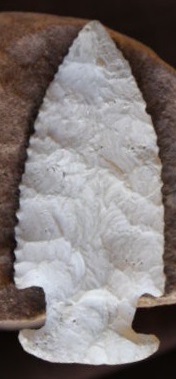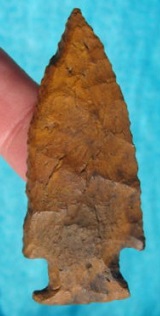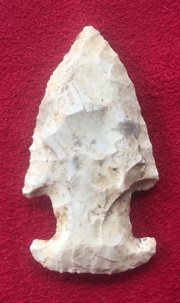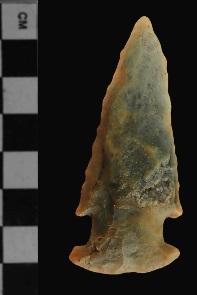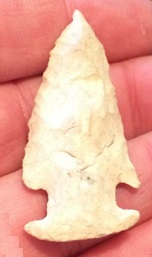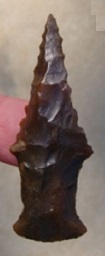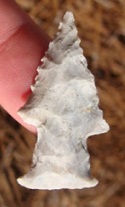Outline is Representative of Size and Shape:
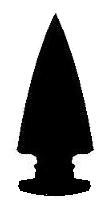

Name Details:
Identified By: Wilfred T. Neill
Named For: Type Site
Date Identified: 1963
Type Site: Bolen Bluff Site, Florida
Identified By: Wilfred T. Neill
Named For: Type Site
Date Identified: 1963
Type Site: Bolen Bluff Site, Florida
Point Validity:
Valid type
Neill was a herpetologist who taught herpetology, ecology and archaeology at Pasco-Hernando Community College in Florida. He named this point in a professional publication and this type has many professional references to the extended (Bullen's type 5). This is considered a valid type. The E-notch variant first appeared in collector sources and has many collector references, but no professional recognition. The E-Notch variant is a collectors type.
Neill was a herpetologist who taught herpetology, ecology and archaeology at Pasco-Hernando Community College in Florida. He named this point in a professional publication and this type has many professional references to the extended (Bullen's type 5). This is considered a valid type. The E-notch variant first appeared in collector sources and has many collector references, but no professional recognition. The E-Notch variant is a collectors type.
Bolen Extended / E-Notch
Cluster: Description of Physical Characteristics and Flaking Pattern:
This is a medium size triangular point with an elliptical to rhomboid cross section. The blade ranged from excurvate to straight. This point has parallel notches and the shoulders may be horizontal to barbed. The notch is formed by flake removal at both the top and bottom of the notch forming a long square notch. A protrusion may be formed where the top and bottom notch meet forming an E shaped appearance. The stem is expanded and the base is convex. This point has a random flaking pattern.
Size Measurements:
Total Length - 33 to 72 mm (typically 45 to 55 mm), Stem Length - 15 to 25 mm (typically 20 mm), Width -20 to 34 mm (typically 28 to 34 mm), Stem Width - Typically slightly narrower than shoulders, Thickness - 5 to 11 mm
Total Length - 33 to 72 mm (typically 45 to 55 mm), Stem Length - 15 to 25 mm (typically 20 mm), Width -20 to 34 mm (typically 28 to 34 mm), Stem Width - Typically slightly narrower than shoulders, Thickness - 5 to 11 mm
Commonly Utilized Material:
Chert and coral
Chert and coral
Additional Comments:
The extended notch variant is the same as Ripley Bullen's Bolen Type 5. This variant has a wide notch due to two parallel notches entering the blade forming a wide notch. The base may vary from concave to convex or recurvate.
This point is similar to the Big Sandy E Notch and the Thebes E Notch. This point differs from the Thebes E Notch by distribution and the absents of barbed shoulders, and from the Big Sandy E-Notch by the convex base.
The extended notch variant is the same as Ripley Bullen's Bolen Type 5. This variant has a wide notch due to two parallel notches entering the blade forming a wide notch. The base may vary from concave to convex or recurvate.
This point is similar to the Big Sandy E Notch and the Thebes E Notch. This point differs from the Thebes E Notch by distribution and the absents of barbed shoulders, and from the Big Sandy E-Notch by the convex base.
Distribution: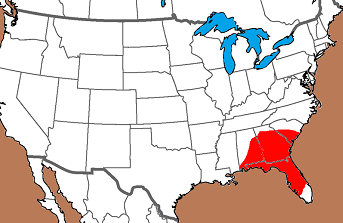

Distribution Comments:
This point is primarily found in northern Florida and as far north as Polk, Cobb, Bartow, and Cherokee county Georgia, southeastern Alabama, and east into the lower Savannah River Valley of South Carolina. This point may be found into central Florida with decreased frequency. This point has rarely been reported into Mississippi and Louisiana coastal regions.
This point is primarily found in northern Florida and as far north as Polk, Cobb, Bartow, and Cherokee county Georgia, southeastern Alabama, and east into the lower Savannah River Valley of South Carolina. This point may be found into central Florida with decreased frequency. This point has rarely been reported into Mississippi and Louisiana coastal regions.
Age / Periods:
Date: 9,5000 - 8,500 B.P.
Cultural Period: Early Archaic
Glacial Period: Early Holocene
Culture:
Date: 9,5000 - 8,500 B.P.
Cultural Period: Early Archaic
Glacial Period: Early Holocene
Culture:
Age Details:

